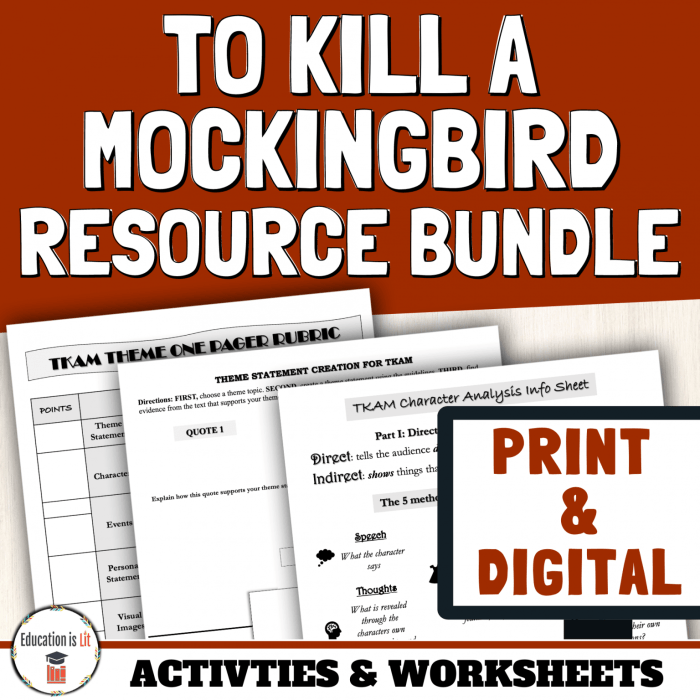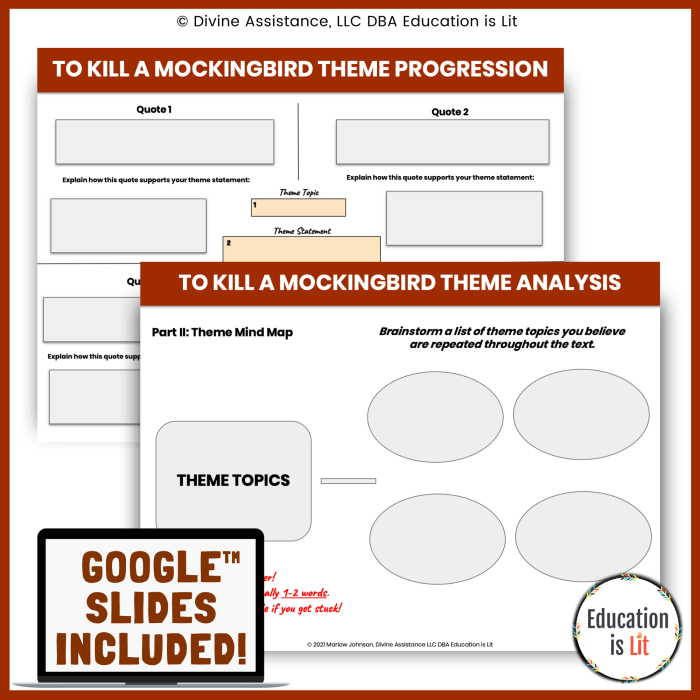Embark on an immersive literary journey with our meticulously crafted To Kill a Mockingbird lesson plans. Designed to unravel the novel’s profound themes, captivating characters, and enduring significance, these plans guide educators in fostering deep engagement and critical analysis among students.
Our comprehensive approach delves into the novel’s historical context, literary techniques, and multifaceted symbolism, providing a holistic understanding of Harper Lee’s masterpiece.
Lesson Plan Overview
To Kill a Mockingbirdis a seminal work of American literature that has captured the hearts and minds of readers for generations. Its timeless themes of racism, justice, and empathy have made it a staple in classrooms and a powerful force for social change.
The novel is set in the American South during the Jim Crow era, a time of rampant racial segregation and discrimination. It follows the story of Atticus Finch, a white lawyer who defends a black man falsely accused of rape, and his children, Scout and Jem.
Through their experiences, the novel explores the complexities of race, prejudice, and the power of compassion.
Key Themes and Literary Devices
- Racism and prejudice
- Justice and injustice
- Empathy and compassion
- Foreshadowing and irony
- Symbolism and allegory
Character Analysis
Atticus Finch
Atticus Finch is a complex and morally upright character who serves as a beacon of justice and compassion in the novel. He is a single father who raises his children, Scout and Jem, to be independent, critical thinkers with a strong sense of empathy.
Atticus is a lawyer who defends Tom Robinson, a black man falsely accused of rape, despite the social consequences he faces. He teaches his children the importance of standing up for what is right, even when it is unpopular.
Scout Finch
Scout Finch is the narrator of the novel and provides a unique perspective on the events that unfold. She is a tomboyish and intelligent girl who is curious about the world around her. Scout learns about the complexities of race and prejudice through her experiences with her father and the people of Maycomb.
Boo Radley
Boo Radley is a mysterious and enigmatic character who lives in a dilapidated house across the street from the Finches. He is rumored to be a dangerous and violent recluse, but Scout and Jem come to learn that he is a kind and gentle soul who is misunderstood by the community.
Symbolism and Motifs

To Kill a Mockingbirdis rich in symbolism and motifs that enhance the novel’s themes and characters.
Symbolism
- The mockingbird represents innocence and the destruction of innocence.
- The Radley house represents mystery and the unknown.
- The oak tree represents strength and resilience.
Motifs
- Justice and injustice
- Prejudice and racism
- Childhood and innocence
Historical Context
To Kill a Mockingbirdis set in the American South during the Jim Crow era, a time of widespread racial segregation and discrimination. The novel reflects the social and racial tensions of its time and explores the impact of racism on individuals and communities.
The Jim Crow era lasted from the late 19th century to the mid-20th century. During this time, African Americans were subjected to a system of legalized segregation and discrimination in all aspects of life, including education, housing, employment, and transportation.
The novel portrays the injustices and prejudices that African Americans faced during this era.
Themes and Literary Techniques: To Kill A Mockingbird Lesson Plans
Central Themes
- Racism and prejudice
- Justice and injustice
- Empathy and compassion
Literary Techniques
- Foreshadowing
- Irony
- Symbolism
- Allegory
Harper Lee uses a variety of literary techniques to enhance the novel’s themes and characters. Foreshadowing is used to hint at events that will happen later in the novel, creating a sense of suspense and anticipation. Irony is used to highlight the contradictions and injustices of society.
Symbolism is used to represent abstract ideas and emotions, adding depth and complexity to the novel’s characters and events.
Class Activities and Discussions

There are a variety of engaging class activities and discussions that can be used to explore the themes and characters of To Kill a Mockingbird.
Class Activities
- Have students create a timeline of the events in the novel.
- Have students write a letter from the perspective of one of the characters.
- Have students create a poster or presentation on one of the novel’s themes.
Group Discussions, To kill a mockingbird lesson plans
- Discuss the role of racism and prejudice in the novel.
- Discuss the importance of justice and empathy.
- Discuss the symbolism and motifs in the novel.
Assessment and Evaluation
There are a variety of ways to assess students’ understanding of To Kill a Mockingbird.
Assessment Rubrics
- Create a rubric for assessing students’ essays on the novel.
- Create a rubric for assessing students’ presentations on the novel.
Literary Analysis Skills
- Assess students’ ability to identify and analyze literary devices.
- Assess students’ ability to interpret the novel’s themes and characters.
- Assess students’ ability to write critically about the novel.
Question & Answer Hub
What is the significance of To Kill a Mockingbird in American literature?
To Kill a Mockingbird is widely regarded as a classic of American literature, exploring complex themes of race, justice, and innocence. It has been praised for its insightful portrayal of the American South during the Jim Crow era and its enduring relevance to contemporary society.
How do the lesson plans analyze the novel’s characters?
Our lesson plans provide in-depth character analysis, focusing on the development and motivations of key figures such as Atticus Finch, Scout Finch, and Boo Radley. Students will explore the characters’ relationships, conflicts, and the ways in which they embody the novel’s themes.
What literary techniques are examined in the lesson plans?
The lesson plans delve into Harper Lee’s skillful use of literary techniques, including foreshadowing, irony, and symbolism. Students will analyze how these techniques contribute to the novel’s plot, character development, and overall impact.